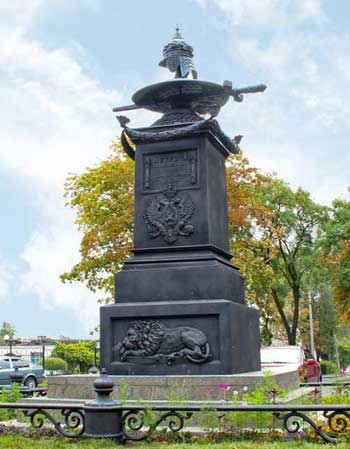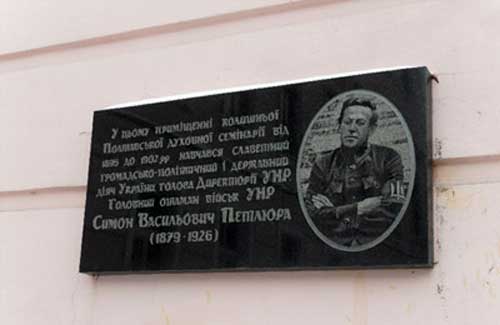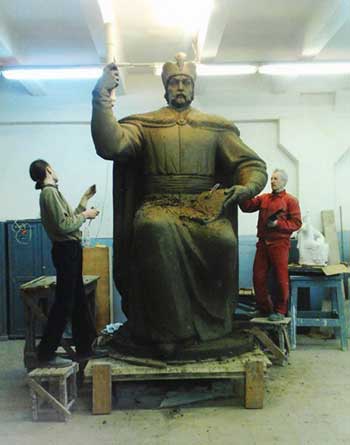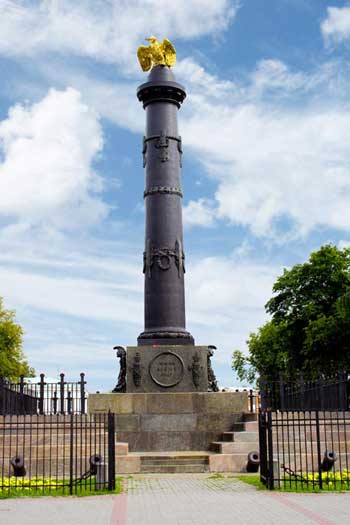Writers, historians, culture experts and philosophers often call Poltava land a spiritual capital, the heart of Ukraine or also its mental, landscape and linguistic benchmark. All of these statements can be basically agreed with, but with some restrictions. Not too scrupulous look at the local toponymy and monuments does prove that the supposedly most Ukrainian region is in no hurry to part with Russian and Soviet imperial legacy reflected in numerous monuments in honour of the Battle of Poltava and in the “communist” street names: Lenin, Frunze, Kuibyshev, Oktyabrska, Karl Liebknecht, Rosa Luxemburg, the Paris Commune, etc. Until recently, there were Karl Marx Street and Radyanska (Soviet) Street that have been renamed after Volodymyr Kozak, a famous oil and gas industry engineer, and Monastyrska respectively. Furthermore, there still are numerous monuments dedicated to Lenin, the leader of the world proletariat, in the administrative centers of the districts of Poltava region; the monuments are attacked by hooligans from time to time who do not only vandalize the busts but also scribe the words “Take me off” on the pedestal.
Conflict of Symbols
The pro-Soviet sentiment of the Poltava population is partly caused by prolonged professional propaganda especially in the sphere of culture and education, which has produced generations of denationalized internationalists having the Moscow-centrist world vision. The additional factor of the nostalgia for the lost grandeur is the presence of a considerable number of former KGB employees and ex-servicemen in the city for whom living in cosy Poltava when being retired was very prestigious.
Meanwhile, local authorities are hardly eager to eternalize the Ukrainian historical figures in fear of being accused of “nationalism” and “violation of the brotherly Russian people’s feelings”. Against this background, the Cross commemorating the fallen Cossacks in Poltava, the monument to Kyrylo Osmak, President of the Ukrainian Supreme Liberation Council, in the district town of Shyshaky or the monument to Borys Martos, Prime Minister of the Ukrainian People’s Republic, in Poltava is rather a rare exception than the rule, as neither Hetman Ivan Mazepa, nor the head of the Directory of the UNR Symon Petliura still have been honoured. They are still “traitors”, “pogromists”, “anti-Semites” and even “Banderovites” for many inhabitants of the region.

Пам’ятник на місці відпочинку Петра І (Полтава)
“The monument to Hetman that has been made on people’s donations and is being covered with dust in the yard of Khudozhnyk Kyiv Plant should have been set almost two years ago in Cathedral Square in the historic centre of Poltava,” Vasyl Neyizhmak, Ukraina Moloda’s reporter, remarks. “At the same time, Ukrainophobics of all stripes keep trying to convince the public that this “monument creative” idea is promoted by a handful of “nationally concerned” politicians. Moreover, their haste is supposedly caused by the need for their own PR campaign before the elections. Although the people in Poltava actually began to speak about the future monument to Mazepa immediately after Ukraine had gained independence” [1].
Probably, the only mark of Petliura’s presence in Poltava is a commemorative plaque with his portrait at a building of the present-day Agricultural College that used to be the Seminary the future Chieftain of the UNR Army attended. His home was destroyed in the 1960s, and outbuildings were finally ruined in 2005 and replaced by a living block. Although, another memorial site that is the home of Petliura’s nephew Stepan Skrypnyk known as Mstyslav, the first Patriarch of the Ukrainian Autocephalous Orthodox Church, was lucky to be kept and fixed up due to enthusiasm of the concerned citizens.
Setting monuments and memorials, Poltava authorities seem trying to choose the least conflicting figures and topics that would reflect the spirit of the land of Hryhoriy Skovoroda, Ivan Kotlyarevsky and Nikolai Gogol, on the one hand, and would not irritate the public feeling nostalgic for “the big country” and “bright past”, on the other one. Perhaps, that is the reason of appearance of the statuary groups dedicated to Gogol’s characters, the monument to a folk singer and poetess Marusia Churai, “the girl from the legend”, that to a pig as “an eternal feeder of the Ukrainian people” and that to a halushka dumpling, maybe the most famous Poltava’s brand.
There is nothing wrong with that, except the obvious disproportion between the number of symbols of imperial grandeur of the winners of the Battle of Poltava and the sites of the heroic struggle for freedom of Ukraine. To some extent, this situation is accounted for the Komsomol education of the current leaders of Poltava and Poltava region who celebrate every anniversary of the Lenin Komsomol establishing, show longing for their past youth at various meetings and announce that their whole family consider Mazepa a traitor like the former Mayor of Poltava, Andrii Matkovsky, did.
Playing with Sociology
Against this ideological background, Oleksandr Mamai, the current Mayor, had seemed to be more progressive until recently. According to him, though he grew up with Marxism-Leninism, was a Little Octobrist, Young Pioneer and Komsomol member, but did not become a communist. “I am not a historian, whereas this issue should be examined by historians,” Oleksandr Mamai convinced the public while being Sovist Ukrainy (Conscience of Ukraine) pragmatic party candidate for the Mayor of Poltava. “But personally I think that if historians decided that Mazepa’s portrait could be on a ten hryvnia banknote it means they know some reason for it. Therefore, this man has done much good for the Ukrainian people. He could not be portrayed there without any special reason” [2]. However, having been chosen the Mayor, he somewhat corrected his attitude towards controversial historical figures and traditionally referred to the results of opinion polls. So, if from 50 to 80 percent of Poltava people oppose establishing the monuments to Mazepa and Petliura, the standpoint of the city authorities will be the same. If there were at least 30 percent of those favouring it, the authorities would listen to their voice.
The sociological studies have been performed by Dr. Mykola Lebedyk from the Independent Centre for Strategic Studies who predicted the victory of the incumbent Mayor. According to the poll, only 6 percent of residents stand for the monument to Mazepa. After publication of the results of the opinion polls, Poltava Mayor has stated that this issue rather falls within competence of the President and the Parliament whose decisions are to be executed, and he supposedly deals only with economic affairs. As if there were no related item in the Decree of President Yushchenko to celebrate the 300th anniversary of the military-political campaign by Ivan Mazepa as well as the relevant resolution of Government of Ukraine and the decision of the City Council (however, the latter was later cancelled).

Пам’ятна дошка С. Петлюрі на приміщенні колишньої духовної семінарії
The same sociological manipulations were used in Poltava by Mr. Mamai’s predecessors in Petliura’s case. Oleksii Logvinov, Coordinator of the Public Committee for the Commemoration of Petliura, has illustrated this technology by the example of renaming Rosa Luxemburg Street in honour of the Ukrainian female singer Raisa Kyrychenko. “They called us from the City Council Executive Committee and asked if we agreed with it. When we said ‘yes’, we were asked the following question: “Do you know it will require reregistering the documents of the street residents?” Mr. Logvinov says. “Contrary to the rules of sociology, it was the suggestive question aimed at intimidating the people and causing them to give a negative answer. Of course, if the similar poll about Petliura was conducted in the same way, the majority gave a negative answer. If the survey were conducted by a reputable, professional and fair polling firm, I think the results would radically differ from those offered by Poltava City Council and the Mayor” [3].
Authenticity of the Imperial Style
In June 2010, during the celebration of another anniversary of the Battle of Poltava, Dr. Valerii Tregubov, Associate Professor of Yurii Kondratiuk National Technical University of Poltava, being an adviser to former Poltava Mayor Andrii Matkovsky, announced the reconstruction of the monument to “valorous commandant of Poltava Colonel Kelin and glorious defenders of the city in 1709.” Actually, this meant that the granite obelisk near Peremoha (Victory) City Park would soon be topped with double-headed eagle that had been dismantled by the Bolsheviks in 1921 as a symbol of the Russian Empire. According to the architect, who, incidentally, considers himself a moderate Ukrainian nationalist, the idea of the reconstruction means restoring the original appearance of the object.
“The monument is imperfect without some elements. For example, suppose someone finds the authentic hands of the Venus de Milo, why not add them to the statue of the goddess?” Dr. Tregubov asks. “They would make a copy of the image that used to be, but the original concept of the sculptor would be restored as well” [4]. By the way, Rotunda of Reconciliation near the Poltava Battle Museum has been built according to the project of that architect. The phrase “Time heals wounds” is written at its pillars in three languages: Ukrainian, Russian and Swedish.

«Полтавський» пам’ятник І. Мазепі в майстерні
Although, the matter is definitely not only the problem of authenticity. “It is significant there is rabid enthusiasm of the Ukrainophobics and Ukrainian-haters, both the Russian ones and Ukrainian ones (including Poltavites), in connection with restoration of all these monuments including Poltava double-headed eagle,” Dr. Andrii M. Okara, Director of the Moscow Center for East European Studies, says. “The Poltava Battle became the starting point for the Russian Empire, and, on the contrary, it became the point of no return for the Cossack Hetmanate of Ukraine” [5].
After the announcement of this Dr. Valerii Tregubov’s initiative, the patriotic community of the city immediately sounded the alarm and accused the architect and municipality officials of the Russian nationalism and servile complaisance. “Tregubov and his supporters prove their intention to promote the Russian imperialism in bronze by the fact the monument looked like this in the Tsarist times and therefore it is “imperfect” with no double-headed imperial eagle. Another “argument” is that “all the work has been funded by a philanthropist” whose name is shyly concealed by the esteemed architect. What if tomorrow another sponsor wishes to restore a monument to Stalin or hang portraits of Russian tsars or Bolshevik leaders on the walls in the city agencies “for the sake of historical justice”?” Prostir Svobody (Space of Freedom) movement of volunteers argues [6]. During Mazepa Fest 2010 Poltava rock festival, the activists of that NGO staged a mini-performance near the monument of Colonel Kelin by gutting a symbolic double-headed mutant chicken and chanting slogans “Mazepa to Poltava, the mutant to a ditch!” and “Down the mutant occupant!”.
The reconstructed monument to the defenders of Poltava had been planned to be unveiled on City Day, 23 September 2010, but the process of “rebirth of sculptural and historical justice” had been suspended before the October municipal elections. Then it was expected that the nationally indifferent Mayor Andrii Matkovsky would be replaced by one of more nationally conscious successors, either businessman Oleksandr Mamai of Sovist Ukrainy pragmatic party or ex-Governor of Poltava region Valerii Asadchev, a member of the centre-right Ukrainian People’s Party. As a result, Mr. Mamai became a convincing winner of the election. Notwithstanding the fact he had spoken highly of Ivan Mazepa during the campaign, he said he did not want to trouble the local community once again, when becoming “Mayor of all Poltavites”.
Instead, the current Mayor prefers the mentioned above initiative of the architect Tregubov to the idea of erecting the monument to Mazepa and does not treat the double-headed eagle on the top of the Monument to Colonel Kelin and defenders of the city as a symbol of the Russian Empire: “Personally, I am not against the (restored. – S. Sh.) monument. Moreover, I liked the original view of the monument very much when seeing it on the Internet. All my maternal and paternal relatives live in St. Petersburg; therefore, my attitude towards Russia is the sincerest. I am sure we need cooperation with Russia, Belarus and Kazakhstan. There must be not only partnership but also friendship between our countries” [7]. Most likely, the eagle with a laurel wreath in claws is to symbolize that indissoluble friendship of fraternal peoples.
Against the background of lack of interest in local government in perpetuating the Ukrainian historical figures, there are rather eccentric counter-proposals on the part of certain political forces. For instance, in August 2010, former candidate for the Mayor Vasyl Kovalchuk of Svoboda (Freedom) nationalist party suggested temporary setting the monument to Mazepa (without a pedestal) in the courtyard of his private house downtown until the national consciousness increases in Poltava that can possibly be waited for years.
“Unfortunately, a large number of society including national and local government live by the values formed by the colonial and communist past, which is firmly rooted in minds of the people,” Mykola Kulchynsky, the head of the Prosvita (Enlightenment) regional branch, MP of the Nasha Ukraina (Our Ukraine) centre-right party, states. “Poltava is full of colonial monuments, so it would be logical for the Ukrainian state to put monuments to its heroes at last, in order to show the people not only its taking care of important social matters but also having its own view of the national history. There should be not only the monuments to “Russian victory” but also those to Ukrainian knights” [8]. He does not support Mr. Kovalchuk’s idea and suggests establishing the Mazepa monument near the Ukrainian Orthodox Church Kyiv Patriarchate Temple of the Holy Protection in one of remote dormitory districts of the city, as a last resort.
Compromise with the Past
The nationally oriented intellectuals, journalists and average patriotic citizens of Poltava seek to establish the monument to Hetman in the city, because the leaders of some other cities (Kalush, Khemelnytsky, Lviv, Ternopil, Bila Tserkva and Ivano-Frankivsk) have expressed willingness to set the “unnecessary” Mazepa on their territory. While the bronze Hetman has been standing in a quite different place that is the yard of Khudozhnyk creative-industrial complex of Kyiv for three years, the double-headed eagle is about to land on the obelisk of the Poltava fortress defenders. Implementation of this concept can cause another wave of protests, so in order to avoid them the patriotic movement activists call on the city leadership to come to senses and stop the actions of this, to say the least, ambiguous symbolic dimension.
The Russian philosopher Dr. Andrii M. Okara who occasionally visits Poltava advises not to consider this issue in black and white perspective. In his opinion, the restoration of the monument in authentic form should be welcome because it is not only one of the monuments in honour of the Battle of Poltava but also the artefact from the beginning of the 20th century. But on the other hand, it is a symbolic manifestation of the Russian idea. So, a compromise should be sought, particularly relevant would be linking initiatives for the eagle on the Monument to Kelin with the question of establishing the monuments to Mazepa and Petliura in Poltava.
“It means Poltava is either a city of the people of free spirit who are not afraid of ghosts from the past and are tolerant to any historical artefacts like the double-headed eagle on the monument to Kelin and Mazepa in the city centre along with Petliura closer to the house where he was born, or Poltava is a city of morally underdeveloped and spiritually limited fanatics, then the double-headed eagle on the Monument to Kelin and Mazepa along with Petliura will have to wait as long as the people grow up,” Dr. Okara concludes [9].

Колона слави (Полтава, 1809 р.)
The problem of memory and monuments certainly concerns not only Poltava, but also many other Ukrainian cities, which symbolic “decoration” are figures of a quite specific brand – the Monument to Catherine II in Odesa, those to Dzerzhinsky and to Stalin in Zaporizhia, monuments to victims of UPA in Luhansk and Simferopol. Let us finally look at Kyiv. Although there are Petliura Street (formerly the Comintern one) and partly Mazepa/Lavra Street (formerly January Uprising Street) in the city, but no monument to either of them is erected. Except for the plaque on the Teacher’s House announcing a monument to Petliura to be set at this place, according to the Decree of President Yushchenko.
“Cultural and humanitarian policy of the current government is now undoubtedly its Achilles heel,” Dr. Vladyslav Hrynevych, Senior Research Fellow at Institute of Political and Ethnic Studies of NAS of Ukraine, writes. “Actually, the last [2010] year showed that the government team simply did not have an acceptable concept for Ukraine’s humanitarian policy. The vacuum has been filled with either criticising President Yushchenko (in the way the blame for failures in economic policy was shifted onto “malicious” actions of Prime Minister Tymoshenko) or attempts to impose the humanitarian policy approaches elaborated in Moscow upon Ukraine. This situation could be considered comic, unless it deals with crucial issues for the Ukrainian state. It deals with its national security, in fact” [10].
However, loyalist attitude of the current authorities not always reflects the views of the entire Ukrainian society within which the gradual process of national self-awareness and rethinking of the postcolonial and post-totalitarian past goes on. For example, a kind of symbols of liberation from the imposed and learned myths in Poltava are Petliura Academic Readings and Mazepa Fest youth popular performance. In the future, it gives a chance for developing a new policy of memory and commemoration of the prominent historical figures.
Sergii Shebelist is PhD (“kandydat nauk”) in Social Communications, Assistant Professor at the Department of Journalism, V.G. Korolenko National Pedagogical University of Poltava, Ukraine.
This is report at the fifth bi-annual International Graduate Student Symposium “New Perspectives on Contemporary Ukraine: Politics, History, and Culture”, January 27-28, 2012 (Centre for European, Russian, and Eurasian Studies at Munk School of Global Affairs, University of Toronto, Canada). It is based on two articles published in the Kyiv newspaper Den’ (The Day) in 2010 and 2011. Author is grateful to Petro Jacyk Program for the Study of Ukraine for support of participation in this academic event.
- Василь Неїжмак, Мазепа переможе, “Україна молода”, 20–21.05.2011, nos. 84–85;
- Валентина Зайченко, Мамай дав зрозуміти, що купюри малюють не дурні;
- Сергій Шебеліст, Полтавська битва за Петлюру, Всесвітня служба радіомовлення України Національної радіокомпанії України, 29.05.2008.
- Ян Пругло, Двоголовий орел у Полтаві – слово за Мамаєм;
- Андрій М. Окара, Не боятися привидів минулого, “День”, 23.02.2011, no. 32;
- Двоголовому орлу – не місце на вулицях Полтави;
- Валентина Зайченко, Попри політичні суперечки у Полтаві пам’ятник Келіну відновлять у первозданному вигляді;
- Сергій Шебеліст, Микола Кульчинський про Івана Мазепу, Всесвітня служба радіомовлення України Національної радіокомпанії України, 20.03.2009.
- Андрій М. Окара, Не боятися привидів минулого.
- Владислав Гриневич, Про “Ахіллесову п’яту”, “День”, 25.03.2011, nos. 52–53;

